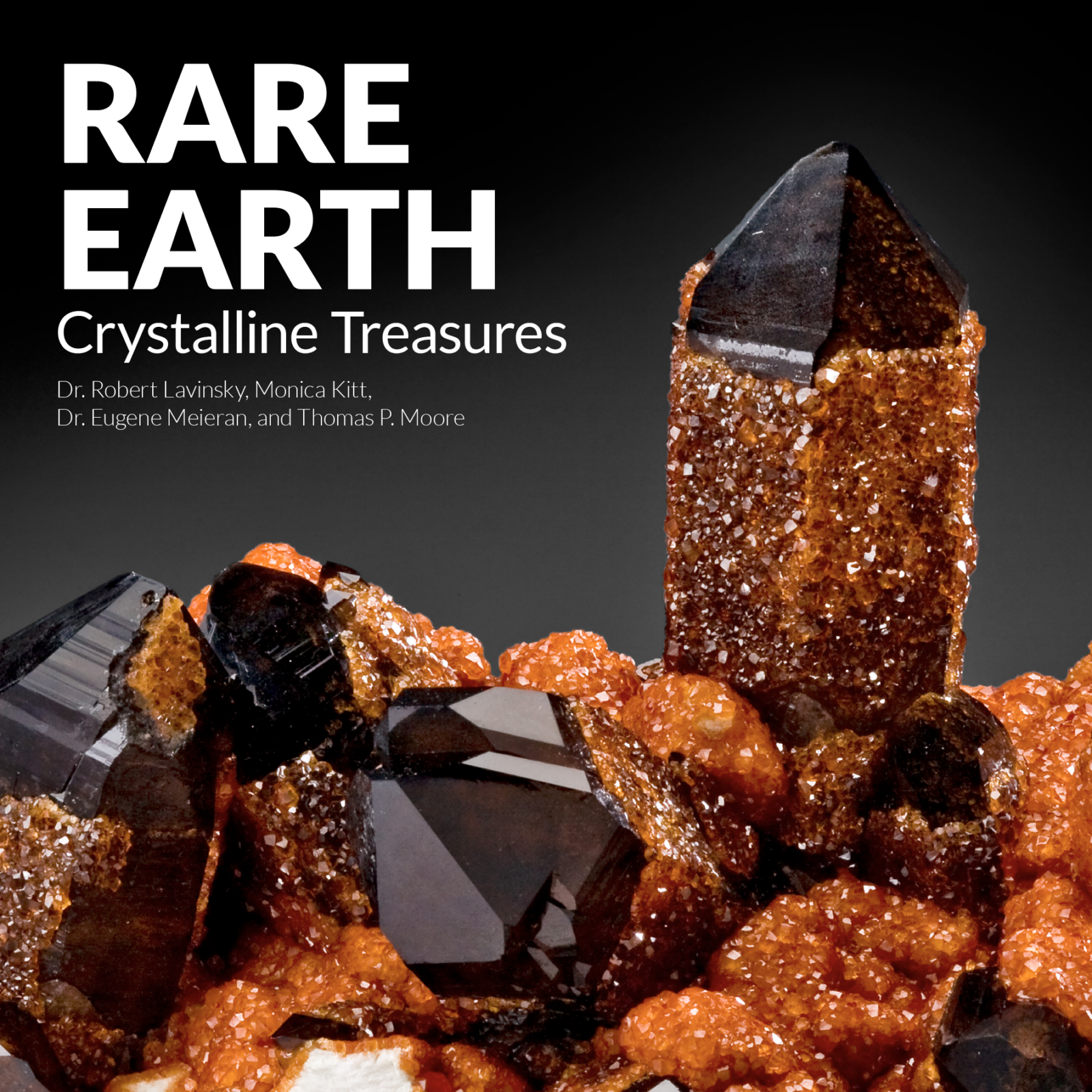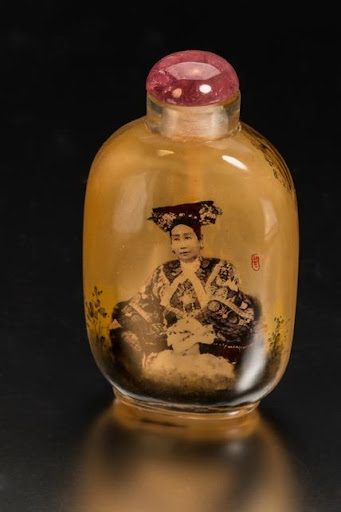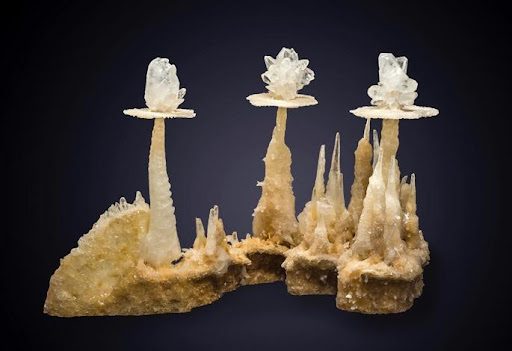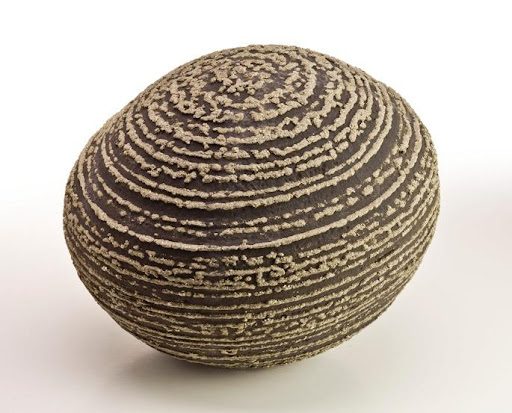Rare Earth: Crystalline Treasures
Exhibition at the Santa Barbara Museum of Natural History
Aaron J. Celestian
Department of Mineral Sciences, Natural History Museum of Los Angeles County
900 Exposition Blvd., Los Angeles, CA 90007
Email: acelestian@nhm.org
Republished with permission

Rare Earth: Crystalline Treasures, running for the summer through September 5th, 2022 at the Santa Barbara Museum of Natural History (fig. 1), brought together more than 200 spectacular mineral specimens from around the world. Many of these were on loan from the renowned collector and mineral dealer, Dr. Rob Lavinsky. The exhibit was uniquely interwoven with various themes and stories that make inspirational connections between architectural design & earth materials, art+science+culture, carvings and illustrations, striking color, fanciful formations, and a few cases at the end that took a deeper dive into crystal form.
The overarching approach of the exhibit, according to Dr. Lavinsky, was “to share the beauty, history, and cultural relevance of these natural works of art using a Beauty Forward approach that outsiders can relate to.” Using Dr. Lavinsky’s world-class collection of Chinese minerals as the foundation, the exhibit explored the long history and appreciation of natural objects for art and cultural expression primarily in Asian cultures. Additional specimens from the museum’s own collection and from the UC Santa Barbara Woodhouse collection draw connections to American culture, in particular the rich mining history in California.
The care in curating and presenting the exhibit was clear from the moment I entered the generous 4000+ sq. ft. Fleischmann Auditorium (an imposing 110-year-old structure with huge red oak beams in the ceiling, fig. 2). Much of the design work was expertly executed by Frank Hein, Director of Exhibits at the SBMNH. Careful attention was given to specimen mounting, lighting, and content writing. The different themes of the exhibit were touched upon in the labeling, which allowed the visitor to explore the exhibition for themselves without being overwhelmed by content full of unfamiliar scientific jargon. Instead of focusing on mineralogical classification in the signage, the exhibit presented a culture-centric approach, making the non-scientist feel at ease, drawing meaningful connections with the deep relationship humans have had with minerals over the millennia, and showing why we continue to study them today. The science in the content labels were presented in an approachable way that carefully intertwines with the bigger stories that the exhibit tells. This effort ensures there are plenty of learning opportunities for everyone in the community, and that nothing distracted your attention from the beautiful objects, and all are put to great effect in Rare Earth.
If you missed making the trip to see this amazing display yourself, the following review covers some of my highlights and I hope to convey the sense of excitement that I felt during my visit on the busy opening weekend.
Commodities as Art
Among the first specimens the visitor viewed when entering the hall are of metals — some of the most amazing metallic pieces that one could ever hope to encounter. It is astonishing to consider that many now lost specimens of native gold, silver, and copper like these were routinely melted to make bars, wires, and pipes. The pillow-like specimen mounts were used effectively to dramatically emphasize just how delicate these minerals are. A prime example is the nearly 10-inch-tall crystalline gold from the famed Eagle’s Nest Mine (See fig. 3). This specimen calls to the crazed rush for gold mining in the mid-1800s, and how it could have been melted down to be sold for a comparatively small sum. Today, gold specimens are far more prized for their natural artistic formation rather than their weight. It is also more scientifically valuable for gold to be preserved in its natural state so that their formation conditions and provenance can be better studied (Tremsin 2017).

Next to the gold was a very large native silver specimen from the Hongda mine in China (see fig. 4). Perhaps unknown to most visitors to the museum, this wire-like morphology of silver is highly sought after by collectors. In historic Chinese culture, silver was more prized than gold. By the 16th century Ming Dynasty, the monetary system was based on silver (Glahn 1996) instead of the bronze that preceded it. This transition to silver came about due many factors, including a huge influx of silver from the Americas during European extraction, a late ‘silver strike’ in Japan in the 1530s, and a historically low gold to silver ratio in China.

Rounding out the metals was an exquisite copper specimen (see Fig. 5) with cuboidal crystals and a subdued oxidized red color that is not commonly found in native copper. This beautiful specimen was included to bluntly represent the paradoxical value of our natural resources; we need metals like this to sustain our evolving modern societal dependencies, yet there is a continued intrinsic value in minerals as art. The exhibit drew attention to this later fact, and yet the practical use of these materials in inescapable.

Beyond native metals, there were other specimens in the exhibit that have striking form and also have important economic and industrial interests. Tin and tungsten are critical elements for cell phones, alternative energy, and other modern devices, that do not have economic deposits of their native metal form, but only occur in substantial quantity as oxides. The massive lustrous and translucent twinned cassiterite specimen (a common ore for tin) (fig. 6) sitting on a small grouping of fine muscovite crystals was one of the finest I’ve seen. A classic gemmy, orange scheelite (a common tungsten ore) specimen was also notable (fig. 7). Large stibnite (principally antimony ore) crystals are not uncommon in museums, but a commanding tower of perfect crystals (fig. 8) was a fantastic addition to the exhibit’s theme. This specimen also impressed upon the use of minerals to the public with a connection to the origin of makeup and the word alcohol itself (from Arabic, al-kuhl, for fine black powder originally derived from distillation processes).


Minerals as Art
Most mineral specimens undergo some degree of preparation prior to display in a museum or even a personal collection. After the mineral is removed from its growth environment, it could be only slightly enhanced, for example through the delicate removal of some surrounding matrix, or it would be wholly transformed, as carried out by the master carvers from Idar-Oberstein and other regions. The artisans of mineral preparation and presentation were not ignored in this exhibit, which had a range of examples from elaborate carvings to specimens that underwent only minimal processing. A citrine Buddha made by legendary carver Michael Peuster of Idar-Oberstein in Germany (fig. 9) was specifically commissioned for this exhibition by Dr. Lavinsky. Records indicate nearly 1,000 years of lapidary history in Idar, and an exhibit having culture + art + science would not be complete without an example from these master carvers. According to Dr. Lavinsky, the carving was designed to “make the viewer reflect upon the contrast of the human use versus the appreciation of crystals in their raw form.” The pedestal and outside walls of the figure are natural and uncarved. Through this work, I could clearly see the relationship of how people and cultures can spiritually relate to the Earth and its materials.

California minerals were sought out by China’s Empress Dowager Cixi (aka Tzu Hsi) in the early 1900s, who especially valued gemmy pink tourmaline. The Empress bought nearly all of the pink tourmaline that came from the mines in San Diego County, and much of the raw material was carved into figurines, decor, and bottles (fig. 10).

A delicately carved dragon combined cherry wood with a natural malachite body (fig. 11). The malachite was sourced from Tonglushan mine (which translates literally to ‘Green Copper Mountain,’ actually the source of copper ore for Bronze Age China 3500 years ago as mentioned in the exhibition), China, and I interpreted this dragon to symbolize people wishing to protect or respect resources they needed from the mountain.

Some specimens had been prepared so exquisitely that they become natural sculptures. The art of preparing minerals for display takes decades to perfect and is often done on samples so embedded in a matrix that they would not be visible otherwise. This turquoise vein network was striking, and I’ve not seen anything like it before. The soft matrix in which the turquoise veins solidified has been removed (carefully, at Lavinsky’s request after mining in China), and the turquoise itself had been slightly polished (fig. 12). The results bring to mind a CT scan of copper ore where the three-dimensional, original hydrothermal fluid network is made visible. Next was an emerald that is unlike any other. This huge (40 cm) spray of columnar green beryl crystals was revealed by carefully removing some of the hard rock that it grew in, and is presented as a natural pocket, in a cathedral display (fig. 13). Not to be missed was a grape-jelly-colored dodecahedral fluorite that had been trapped in a white quartz matrix (fig. 14). Careful chemical treatments were needed to preserve the fluorite while dissolving away the quartz.
Finally, there was an impressive, approximately six-foot-tall shale with celestine crystals (fig. 15). This formation is often called a “chrysanthemum stone” and is known to only come from China. The rock is Permian in age (252-299 Mya). The celestine crystals are thought to have formed under reducing conditions in cavities left behind after calcite dissolved.



Fanciful Geologic Formations
Occasionally the natural habit of a mineral can be truly astonishing, leading one to wonder what geological processes could have led to such stunning displays of crystallization. The calcite ‘lion tails’ specimen from Wenshan mine, China (fig. 16) is nearly three-feet wide and has an amazing morphology. The specimen formed as stalactites growing down from the cave ceiling, eventually reaching a pool below. At the pool interface, a pad of calcite grew around the descending stalactite to form a ring. Underwater, the saturated calcium carbonate solution allowed the growth of larger calcite crystals shown in this upright photo (fig. 16). There is evidence of multiple water level cycles, indicated by the dissolution of calcite seen in the thinned-out sections of stalactites that became submerged as the water
level rose. As with most cave formations, these recorded past climatic events, but none in a more spectacular fashion.

Other cave formations in the exhibit included malachite stalactites from Tonglushan mine, China (fig. 17) which had a very different morphology than calcite. They look like they formed during oscillatory growth from enriched copper carbonate solutions in the cave. Historically, many of these were destroyed, but as local miners learned that there is a market for selling these to collectors, more are now being preserved.

I always find concretions interesting: the glaciolacustrine carbonate silica concretions from British Columbia, Canada with their diverse morphologies; the ever-popular septarian nodules from Yorkshire, England and Utah, USA; and this fun sedimentary concretion with rings of pyrite from Yunnan, China (fig. 18). It is thought that some pyrite began to nucleate prior to the lithification of the sediment, and both the pyrite and the concretion continued to grow for millions of years with increased pressure and temperature.

Symmetry and Form
While many visitors were drawn to mineral exhibits to view dazzling colors and unusual forms, there was always a scientific story that can be told about each piece. However, since each object in the exhibit had the attention of the average visitor for less than 10 seconds, it could be difficult to convey scientific concepts succinctly and effectively. In that short time, how does one talk about science without reverting to tomes of text to accompany the object?
Probably one of my favorite specimens in the exhibit was the intensely colorful fluorite on calcite from Yangaangxian mine, China (fig. 19). If these were common, they would be in every physical geology classroom and definitely in every museum. The overall crystal shape is an octahedron, however, you could clearly see the cubic skeletal construction. The crystal beautifully showed how a basic cube (i.e. a cubic unit-cell) can be stacked to form an octahedron. The color change also demonstrated chemical zoning within the crystal where each color change in the fluorite was caused by the incorporation of trace elements (or sometimes metal vacancies); a visual symbol of the changing hydrothermal fluids from which it grew. There was another one of these specimens in the exhibit, a green octahedral fluorite also built from cubes without color zoning. In my opinion, every museum needs one of these in their halls to demonstrate that not only does the study of Earth materials incorporate many sciences, but minerals are the physical records of past planetary processes and environments.

Along the lines of symmetry and form, there was an entire case dedicated to the rich diversity of calcite morphology. In a quick glance, one could easily see different ways that calcite can grow. Calcite growth morphology is related to the environment of formation, but remarkably little is known about the precise mechanistic controls at the molecular scale that results in the final crystal shape. To see so many different calcite forms in one place, right next to one another, was a great teaching moment in the natural mineral growth diversity and the basics of crystallography to show the diversity of crystal form, and how it could be generated from a seemingly simple rhombohedron building block. There was also a case showing a variety of quartz and of beryl (mostly aquamarine) crystal forms, not just the terminal faces, but prismatic and bladed forms as well.
California Collection
When in California, do as many Californians do: show your best tourmaline, morganite, and kunzite from the famed mines of Southern California. I really liked the “Postage Stamp” blue cap from the Tourmaline Queen mine. Shown in the exhibit was the actual specimen that was featured on the 1974 U.S. 10-cent postage stamp, on loan from an anonymous source. The piece was formerly in the collection of the Smithsonian Institute and was chosen as a stamp to commemorate American gems and mining. Other specimens featured in this stamp collection were petrified wood, amethyst, and rhodochrosite. Other
California tourmalines in the exhibit represented stellar examples from the classic Himalaya (fig. 20) and Tourmaline King (fig. 21) mines, including Andrew Carnegie’s San Diego bluecap from a 1906 discovery, shown publicly for the first time ever.


The Companion Book
The companion book to the exhibit provides more background and details on how the exhibit was developed and the thought process that went into selecting the specimens. It is designed as a coffee table exhibition catalog and companion (by Monica Kitt) with an illuminating introduction by collector and Intel Fellow Dr. Gene Meieran illuminating connections of minerals to the development of all civilizations, arts, and cultures. It also provides more content on how these minerals formed, where they came from, and why it is important to continue the preservation of this natural history. Probably the biggest takeaway from this exceptional yet compact exhibit is that mineral and rock collections preserve a portal to the past and a window into the geological and cultural history of our planet.
References
Tremsin, A. S., Rakovan, J., Shinohara, T., Kockelmann, W., Losko, A. S., & Vogel, S. C. 2017. Non-destructive study of bulk crystallinity and elemental composition of natural gold single crystal samples by energy-resolved neutron imaging. Scientific reports, 7(1): 1-9. Myth and Reality of Chinas Seventeenth-Century Monetary Crisis. (1996). The Journal of Economic History, 56(2): 429–454.
Biography
Aaron Celestian is the Curator of Mineral Sciences at the Natural History Museum of Los Angeles County, and he is also an Adj. Assoc. Professor of Research in the Dept. of Earth Sciences at the University of Southern California, and an Affiliate Research Scientist at NASA-Caltech Jet Propulsion Laboratory.



